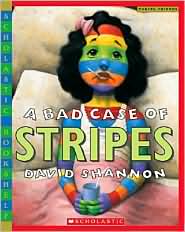"Lightning jerks the sky awake to take her photograph, flash!
Which draws grumbling complaints or even crashing tantrums from thunder--
He hates having his picture taken, so he always gets there late."
 |
| goodreads.com |
Citation
Park, L.S. (2007). Tap dancing on the roof: Sijo (poems). New York: Clarion Books.
Summary
Linda Sue Park introduces a little known form of poetry known as sijo. Originating in Korea, a sijo is composed in a syllabic structure. It has three lines, each with fourteen to sixteen syllables. True to its Asian roots, there is more emphasis on the number of stressed syllables than the number of all syllables. To facilitate writing sijo in English, the three lines are sometimes shortened into six. The fun of a sijo lies in the third line, which usually contains an unexpected twist or joke. The poems can be about any topic, which allows for greater creativity than the Japanese Haiku. The sijo contained within Tap Dancing on the Roof are clever plays on everyday childhood occurrences, from long division to the seasons of the year, to daily routines. A discussion of the poetry form and tips for writing sijos are included.
My Impression
As a somewhat hesitant poetry reader, I was immediately drawn in by the novel (to me!) form and the simplicity of each poem. Offering an easy step into the world of more structured poetry, Park's sijos are easy to understand and fun to read. She stays true to the form without the poems feeling forced and delivers an understated, but perfect, twist or playful conclusion to each. The sketchy illustrations have a somewhat Korean feel, evoking the culture in which the sijo was born while still appealing to American children. While I am no expert, I picked up on the stressed syllables every once in a while, and noticed they lent the poem a very subtle rhythm.
Review
School Library Journal
"Gr 2-6 --Sijo is a traditional Korean form of poetry that
can take two different shapes, three lines or six lines, using a strict
syllable count as haiku does but with distinct differences. All of the lines
have a purpose: in a three-line poem, the first one would be the introduction,
the second would continue the theme, and the third and final line holds a sort
of punch line, be it a play on words or a whimsical observation. Park's sijo,
28 in all, harmonize with illustrations that are deceptively simple at first
glance, but have a sophistication and wise humor that will make viewers smile,
and at second glance make them think. The selections are thoughtful, playful,
and quirky; they will resonate with youngsters and encourage both fledgling and
longtime poets to pull out paper and pen. The author's note includes historical
background on sijo, further-reading suggestions, and a helpful guide to writing
in the form. A smart and appealing introduction to an overlooked poetic form."
Moorhead, S. (2007). [Review of the book Tap dancing on the roof: Sijo (poems) by L. S. Park]. School Library Journal, 53(11), 111. Retrieved from http://www.schoollibraryjournal.com.
Suggested Library Uses
- Host a poetry writing workshop, for all ages or specifically elementary children. Teach a variety of different poems that can be mastered by the attendees and invite them to write their own poems, whether they conform to any structure or not. Short poems can be displayed around the library or entered into a poetry contest.
- Display with other poetry books. A sijo can also be incorporated into a storytime or other children's activity to bring the group together and set the mood for the event.
- The book could also be used to supplement an event teaching about Korean culture and/or literature.
Find it @ Your Library - Albany County Public Library
J 811.54 P219T






